Robert hooke 1665 - Study guides, Class notes & Summaries
Looking for the best study guides, study notes and summaries about Robert hooke 1665? On this page you'll find 89 study documents about Robert hooke 1665.
Page 3 out of 89 results
Sort by
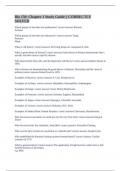
-
Bio 150: Chapter 1 Study Guide || CORRECTLY SOLVED
- Exam (elaborations) • 2 pages • 2024
- Available in package deal
-
- $7.99
- + learn more
Which groups of microbes are prokaryotes? correct answers Bacteria Archaea Which groups of microbes are eukaryotes? correct answers Fungi Protozoa Algae What is cell theory? correct answers All living things are composed of cells. What is germ theory of disease? correct answers Germ theory of disease demonstrates that a specific microbe causes a specific disease. Who observed the first cells, and developed the cell theory? correct answers Robert Hooke in 1665. Who is known for ...
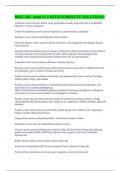
-
BIOL 240 - exam #1 || WITH COMPLETE SOLUTIONS.
- Exam (elaborations) • 4 pages • 2024
- Available in package deal
-
- $10.49
- + learn more
symbiosis correct answers Refers to the partnership (usually long term) that is established between 2 or more organisms 3 kinds of symbiosis correct answers mutualism, commensalism, parasitism Pathogen correct answers anything that causes disease infectious disease correct answers disease caused by a microorganism that disrupts normal body functions emergent infectious disease correct answers an infectious disease previously not described or not been common for at least the prior 20 ...
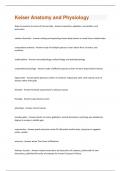
-
Keiser Anatomy and Physiology Questions and Answers with complete solution
- Exam (elaborations) • 7 pages • 2024
- Available in package deal
-
- $6.99
- + learn more
Ways to examine structure of human body - Answer-inspection, palpation, auscultation, and percussion cadaver dissection - Answer-cutting and separating human body tissues to reveal tissue relationships comparative anatomy - Answer-study of multiple species to learn about form, function, and evolution subdisciplines - Answer-neurophysiology, endocrinology, and pathophysiology comparative physiology - Answer-study of different species to learn to learn about body functions hippocrates - Ans...
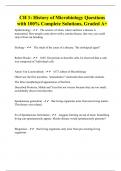
-
CH 1: History of Microbiology Questions with 100% Complete Solutions, Graded A+
- Exam (elaborations) • 5 pages • 2024
-
Available in package deal
-
- $11.99
- + learn more
Epidemiology - The science of when, where and how a disease is transmitted. How people come down with a certain disease, that way you could stop it from out breaking Etiology - The study of the cause of a disease, "the etiological agent" Robert Hooke - 1665, first person to describe cells, he observed that a cork was composed of "individual cells Anton Van Leeuwenhoek - 1673, father of Microbiology Observed- the first microbes- "animalcules"=molecules that acted like a...
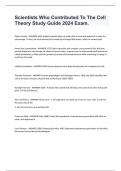
-
Scientists Who Contributed To The Cell Theory Study Guide 2024 Exam.
- Exam (elaborations) • 1 pages • 2024
-
Available in package deal
-
- $10.49
- + learn more
Scientists Who Contributed To The Cell Theory Study Guide 2024 Exam. Robert Hooke - ANSWER 1665 -English scientist that cut a thin slice of cork and looked at it under his microscope. To him, the cork seemed to be made up of empty little boxes, which he named cells. Anton Van Leewenhoek - ANSWER 1673 Dutch naturalist who created a very powerful (for the time period) single lens microscope, He observed pond water. In pond scum he discovered small animals he called animalcules,or little an...
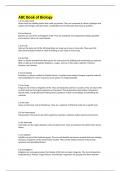
-
ABC Book of Biology
- Exam (elaborations) • 3 pages • 2024
-
- $10.39
- + learn more
ABC Book of Biology A is for Amino Acid Amino Acids are building blocks that make up proteins. They are composed of carbon, hydrogen and oxygen and nitrogen and side chains. Combinations of 20 molecules that make up proteins. B is for Bacteria Bacteria are one of the six kingdoms of life. They are unicellular microorganisms lacking organelles and a nucleus. Some can cause disease. C is for Cell Cells are the basic unit of life. All living things are made up of one or more cells. Th...
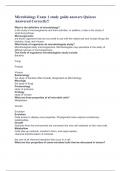
-
Microbiology Exam 1 study guide answers Quizzes Answered Correctly!!
- Exam (elaborations) • 13 pages • 2024
-
- $14.49
- + learn more
Microbiology Exam 1 study guide answers Quizzes Answered Correctly!! What is the definition of microbiology? is the study of microorganisms and their activities. In addition, it also is the study of small living things. Microorganisms are those organisms that are too small to see with the naked eye and include things like bacteria, fungi, and viruses. What kinds of organisms do microbiologists study? Microbiologists study microorganisms. Microbiologists may specialize in the study of dif...

-
Anatomy and Physiology I Final Exam Study Guide From Exam 1: Lesson 2 (slides 3-18, 21-31, 35-52) Introduction
- Exam (elaborations) • 40 pages • 2023
-
- $12.49
- + learn more
Anatomy and Physiology I Final Exam Study Guide From Exam 1: Lesson 2 (slides 3-18, 21-31, 35-52) Introduction • 1665 Robert Hooke inspected thin slices of cork and found they consisted of millions of small, irregular units • This research produced the cell theory o Cells are building blocks of all plants and animals o All cells come from division of preexisting cells o Cells are smallest units that perform all vital physiological functions o Each cell maintains homeostasis at cellular...
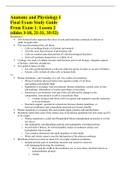
-
Anatomy and Physiology I Final Exam Study Guide From Exam 1: Lesson 2 (slides 3-18, 21-31, 35-52)
- Exam (elaborations) • 40 pages • 2023
-
Available in package deal
-
- $13.49
- + learn more
Anatomy and Physiology I Final Exam Study Guide From Exam 1: Lesson 2 (slides 3-18, 21-31, 35-52) Introduction • 1665 Robert Hooke inspected thin slices of cork and found they consisted of millions of small, irregular units • This research produced the cell theory o Cells are building blocks of all plants and animals o All cells come from division of preexisting cells o Cells are smallest units that perform all vital physiological functions o Each cell maintains homeostasis at cellular...
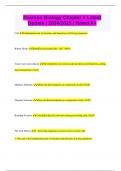
-
Pearson Biology Chapter 4 Latest Update | 2024/2025 | Rated A+
- Exam (elaborations) • 7 pages • 2024
-
- $10.06
- + learn more
Pearson Biology Chapter 4 Latest Update | 2024/2025 | Rated A+ Cell Fundamental unit of structure and function in all living organisms Robert Hooke Identified and named the "cell" (1665) Anton van Leeuwenhoek Developed his own microscope and discovered bacteria, calling them animalcules (1674) Matthias Schleiden Observed that all plants are composed of cells (1838) Theodor Schwann Observed that all animals are composed of cells (1839) Rudolph Virchow Concluded that all cells arise from...

How did he do that? By selling his study resources on Stuvia. Try it yourself! Discover all about earning on Stuvia


